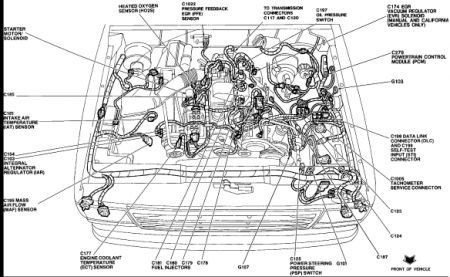The 1993 Ford Ranger uses an OBD-I system, not OBD-II. Therefore, it doesn’t have an OBD2 connector. Instead, it utilizes a diagnostic connector often referred to as the Assembly Line Data Link (ALDL) connector. Locating this connector is crucial for retrieving diagnostic trouble codes (DTCs) to troubleshoot engine issues and the “Check Engine” light.
Where to Find the 1993 Ford Ranger ALDL Connector
The ALDL connector on a 1993 Ford Ranger is typically found under the hood, on the driver’s side. It’s often positioned near the firewall, under a small black protective cover. However, in some models, it might be located on the passenger side, also under the hood and near the firewall.
 1993 Ford Ranger ALDL Connector Location
1993 Ford Ranger ALDL Connector Location
The connector itself is usually rectangular and has a series of pins. It may be partially hidden by wiring or other components, so you may need to look carefully. Once you locate the black cover, simply remove it to access the ALDL connector.
Retrieving Diagnostic Trouble Codes (DTCs)
While the 1993 Ford Ranger doesn’t use an OBD2 scanner, you can still retrieve codes using a specific procedure. This typically involves using a jumper wire to connect specific pins on the ALDL connector, then observing the flashing “Check Engine” light to decipher the codes.
Alternatively, you can use a code reader specifically designed for OBD-I systems. This tool connects to the ALDL connector and displays the codes directly, eliminating the need for manual interpretation.
A detailed guide on retrieving codes for Ford vehicles with OBD-I systems can be found here: https://www.2carpros.com/articles/ford-lincoln-mercury-obd1-1995-and-earlier-diagnostic-trouble-code-definition-and-retrieval
Importance of Diagnosing Trouble Codes
Accessing and understanding the diagnostic trouble codes on your 1993 Ford Ranger is essential for effective troubleshooting. These codes provide valuable insights into the potential causes of engine problems, allowing for quicker and more accurate repairs. Whether you use a jumper wire or an OBD-I code reader, retrieving these codes is a crucial first step in addressing any “Check Engine” light concerns. Don’t hesitate to consult a qualified mechanic if you encounter difficulties in locating the connector or interpreting the codes.
